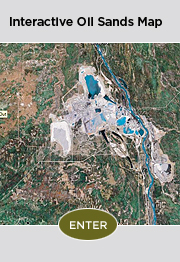The Process
The mining process begins by clearing trees and brush and removing the top layer of earth to expose the ore body. The overburden – the topsoil, muskeg, sand, clay and gravel – is then stockpiled so it can be replaced in layers as the mined-out areas are reclaimed. The rest of the overburden, along with the sand that has been stripped of its oil, is used to fill in the mine pits and construct the base for the reclaimed landscape.
Integrated oil sands mining operations accomplish three main functions: mining the oil sands, separating the bitumen from the sand and upgrading the bitumen so refiners can work with it.
The mining process in a nutshell is:
- Trucks take the oil sands to crushers where it is prepared for extraction.
- The crushed oil sand is mixed with warm water and fed through a hydro-transport system to an extraction* plant where the mixture of oil, sand and water is placed in separation vessels.
*Note: when the oil sands extraction process was first developed, it operated at about 80 degrees centigrade; today the process is much more environmentally friendly and has a lower operating cost. This is because the technology has been evolved to require much less thermal energy to separate the oil from the sand with the operating temperature of the extraction initially being reduced to 60°C and now further refined to allow ore processing to occur at even lower (40°C) temperatures, resulting in still further energy use reductions.
- In the separation vessels, injected air forms tiny bubbles, which are then trapped in the bitumen as it separates from the sand granules. The air bubbles float the bitumen to the surface where it forms a thick froth that is then skimmed off, mixed with Naphtha and spun in a centrifuge to remove the remaining solids and water and dissolved salts from the bitumen. The cleaned sand and the water are then sent to the tailings area where the water is recycled back to the extraction process.
|
|
|
Recently “Natural Froth Lubricity” has been introduced. Natural Froth Lubricity uses water from the mixture to create a lubricating froth, allowing the bitumen to move even faster through the pipeline without having to dilute it further. This innovation allows mines to be separated from the upgrader and yet still be fully heat integrated. For example, Syncrude pumps hot water, reclaimed from the waste heat produced by its Mildred Lake Upgrader to its Aurora Mine, 40 kilometres to the north.
At the Aurora mine, the hot water provides a significant portion of the heat used to extract the bitumen from the ore produced at that location resulting in a substantial reduction in the energy that would otherwise be used. The cooler water is then returned, along with the bitumen, to the Mildred Lake Upgrader where the bitumen feeds the upgrader and the water is reheated and again returned to the Aurora Mine.
Mining technology continues to evolve in a way that shortens the distance between the mine face and the location of primary extraction, reducing overall energy use as a result of shortening the distance the ore must be hauled or transported and lifecycle greenhouse gas (GHG) emissions of oil sands mining operations. |
|




















